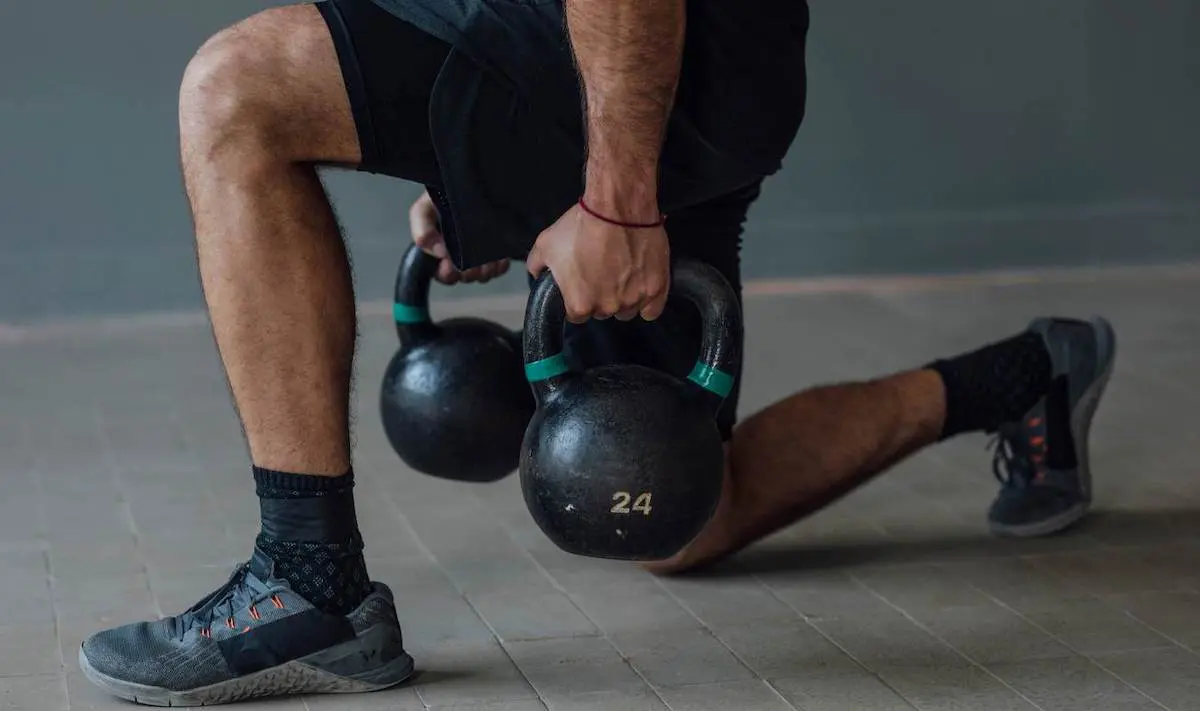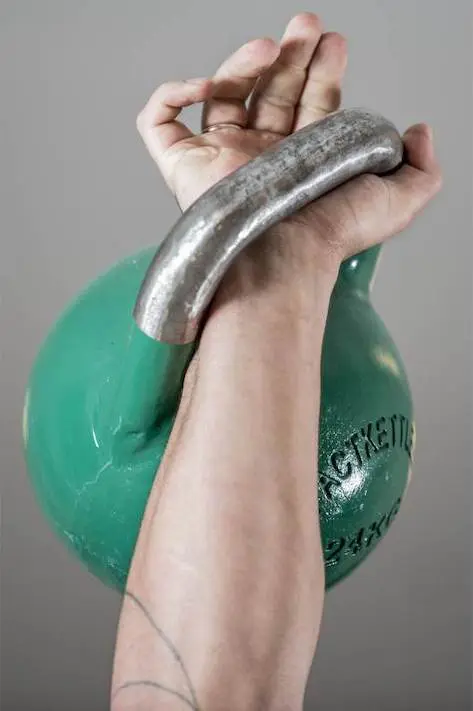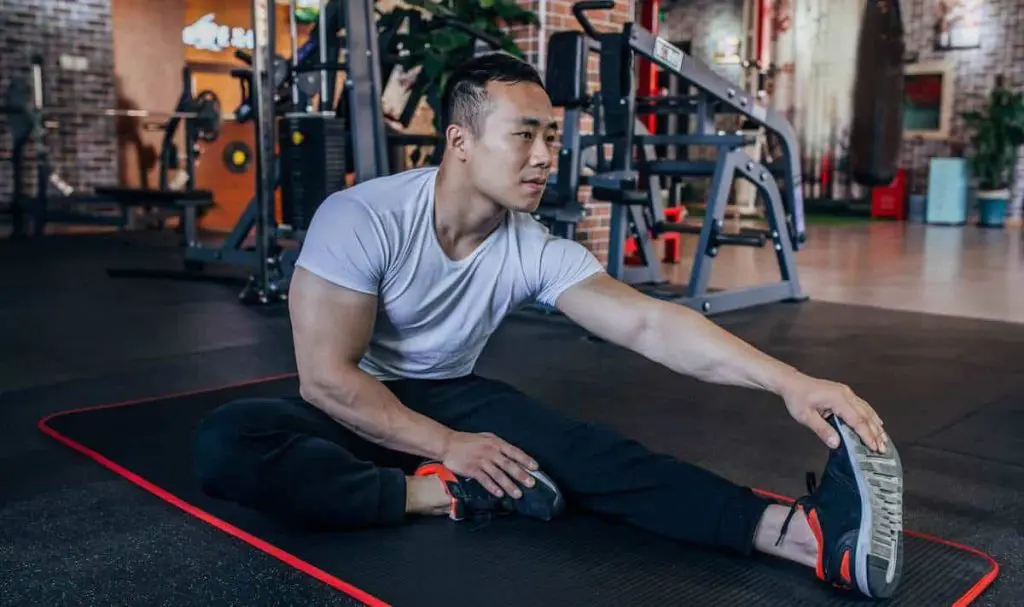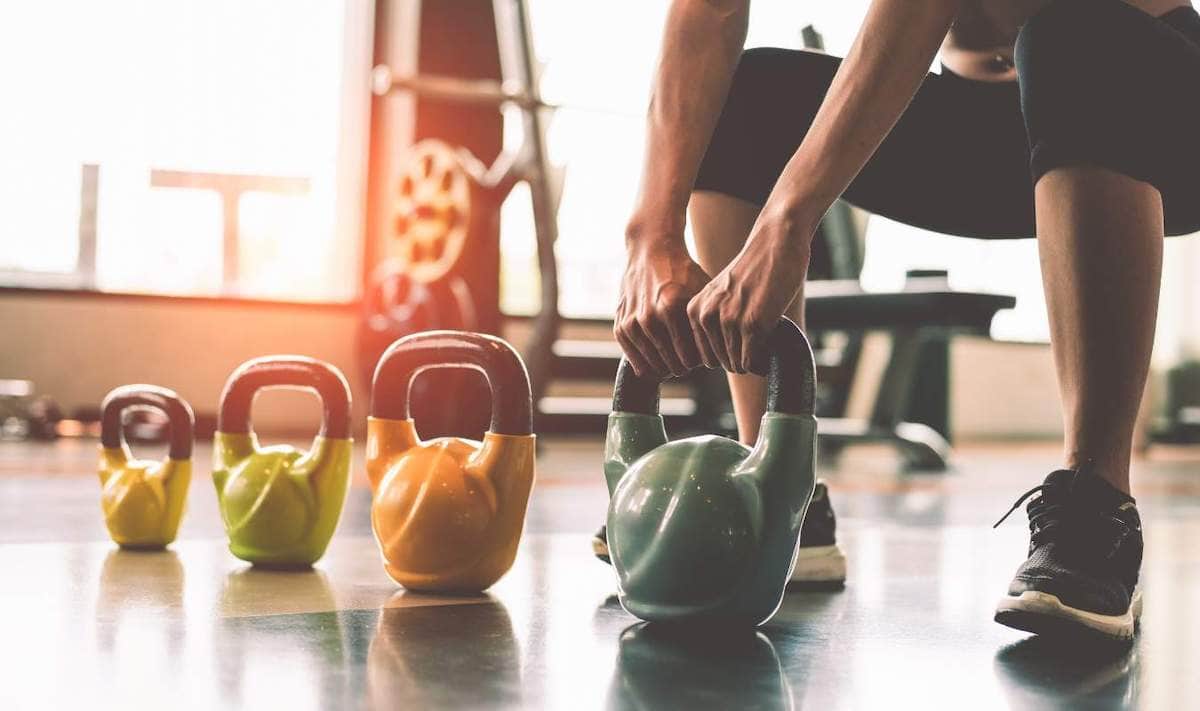
The best online fitness resource you'll ever need. We filter out the BS to ensure you meet your health and fitness goals!

The best online fitness resource you'll ever need. We filter out the BS to ensure you meet your health and fitness goals!

In this 4 Week Kettlebell Program you’ll find a unique routine that can improve your cardiorespiratory capacity, stamina, endurance, strength, and of course, build muscle – just by using the good ol’ kettlebell!
This program is for all fitness levels and abilities – beginners or advanced individuals alike.
All you need is a complete set of kettlebells, motivation, and the right program (i.e. this one!). The motivation is up to you.
Jump to the workout plan now!
Alternatively, you can download the free Kettlebell Workout PDF using the link below:
| Program style | Kettlebell resistance training |
| Program duration | 4 weeks |
| Target Gender | Male and female |
| Target Muscles | Full body |
| Workout duration | 40 mins – 1 hour |
| Scheduling | 5 day split |
| Goal | Build muscle |
| Level | Beginners to advanced |
| Equipment | Kettlebells, bench |
Yes. You can definitely build muscle using only kettlebells.
Kettlebells are typically more associated with dynamic, compound movements due to their inherent shape, making it tougher to hone in on specific muscle groups.
This doesn’t mean you can’t build muscle with kettlebells. We just need to adjust the way they’re typically used. So instead of kettlebell swings and cleans, you’ll instead be doing traditional bodybuilding movements like curls and deadlifts and presses.
As with any resistance training exercise, progressive overload and proper biomechanics are what makes the difference. In many cases, kettlebells check both those boxes as long as you have an adequate range of kettlebell weights.
Now…
If the question becomes “Can you build muscle better or faster using kettlebells only”, the answer changes to probably not.
For the best possible program, and for the uber-serious resistance exerciser, you need a well-outfitted home gym or a commercial fitness center where you’ve got at least a heavy duty cable machine and a barbell or hex bar.
You can expect to work out all the body’s major visible muscle groups once a week. For the larger muscle groups, you’ll get extra work.
If you’re new to resistance training, expect to see some impressive gains. The exercises in this program have been carefully selected and grouped using lengthy periods of experimentation and research of the clinical data on resistance exercise.
Assuming you’re eating right and don’t have a lot of excess body fat to shed, you can expect to see favorable shape changes and some strength gains.
Please note that this is a physique program and not a strength program. Those two objectives are not mutually inclusive, although there is some overlap in training methodologies.
Those more interested in increasing strength should try our 12 Week Strength Training Program.
Kettlebells are an extremely effect tool for building muscle and improving overall fitness. Some of its advantages include:
Our Kettlebell Program breaks down like this in summary:
| Day | Split |
|---|---|
| 1 | Legs, Arms |
| 2 | Shoulders |
| 3 | Rest |
| 4 | Chest, Grip |
| 5 | Back, Glutes, Calves |
| 6 | Cardio, Abs |
| 7 | Rest |
Leg and Arm Day feature some gym favorites for shape, density (aka tone), and strength.
The heel-elevated variety has become much more popular over the past couple of years as the (pointless) dogma around traditional squat stance has given way to good sense.
They favor a wide range of leg lengths and don’t require auxiliary foot dorsiflexion work. With heels elevated, the ankle doesn’t need to bend nearly as much to allow the upper and lower legs to come together.
The closer the upper and lower legs get to one another during a squat, the greater the range of motion. That upper-lower leg approximation is what makes A$$-To-Grass (ATG) squats effective.
The problem with ATG squats is that not everyone’s anatomy (hip socket construction, upper and lower leg bone lengths, and upper body length) is built for ATG squats. None of that’s an issue with heel-elevated so anyone can get a full ROM.
Biomechanically, elevating the heel positions the lower leg as a more active lever for the thigh muscles, which equates to more effect during squatting. A more active lever means more target muscle involvement and greater potential gains.
It also allows for a more erect, vertical path of descent, which again, biases the quads over the glutes, and safer for the lower back.
Finally, the heel-elevated stance provides some surprise hip adductor work. Hip adductors enhance the overall shape of the upper leg and are a key physique component of today’s modern fit look.
Never fear if you’re looking for a lot of glute work on Leg Day. You’ll get your glute in our 4 Week Kettlebell workout program. We’ve programmed glute work into Leg Day (Day 1) and in Glute-Back Day (Day 4).
Arm exercises feature the classic biceps and triceps movements.
Kettlebells work great for building capped delts and thickness around the shoulders.
Trap work was included in Shoulder Day because traps are, technically, a shoulder muscle. They’re functionally responsible for moving the shoulder blades (scapulo-thoracic joint).
Resist the temptation to use too much weight by being super-disciplined on rep speed and form.
Your glutes are one of your body’s largest muscles. They’re important for both function and physique. You’ll move better with healthy glutes and your clothes will probably also fit better too.
Ladies today want shapely, toned glutes. Guys don’t seem to be quite as interested, but they should be.
If you’re a guy, trust me when I say you need to prepare for the future and work your backside. One of the most cringeworthy sites in the gym is an old dude with an elephant-ear butt. Work your butts in your 20s and 30s, guys.
As far as back work is concerned, candidly, cables beat kettlebells. There’s just more you can do with a cable machine and they’re better suited for lining up your muscles with the resistance.
Still, there are some time-tested kettlebell exercises that can get the job done. You’ll just need to be very vigilant on exercise form and paying attention to the details.
Pause for five to 10 seconds in the bottom stretched position. Longer if you can stand the discomfort. Recent research into calf muscle hypertrophy suggests that prolonged stretch can build muscle thickness. It is important to know that the study looked at prolonged stretching and not long pauses during a set. I’m applying some logic here that a longer stretched position during a set has its benefits.
Whether you like a long pause at the bottom or not, calf raises should be performed slowly and under control. Quickly bouncing up and down is just a waste of time.
Kettlebells do a perfectly excellent job at training the chest. And when we say “chest” we mean the pectoralis major and anterior deltoid muscles.
The pectoralis major is a fan-shaped muscle that’s responsible for moving your arm across your chest in a number of angles. For that reason, we can train it thoroughly with kettlebells by adjusting the direction we lift.
Kettlebell Bench Presses involves the pec major and anterior delts in pretty much equal degrees.
Decline KB Press slightly biases the sterno-costal (lower pec) region; however, data shows that this pressing angle may be biomechanically best for training the entire pec.
Some champion bodybuilders have relied most on decline press to build impressive chests, without the use of other chest exercises.
Underhand KB Press will surprise you. If you use the correct form, you’ll feel this in the upper region of the chest near your collarbone and the area just below it near your mid-sternum.
Chest Day in our 4 Week Kettlebell Program features three KB bench presses. Each one orients the pushing direction in a way that targets the regions of the pec major. We’ve also included cable flyes for good measure.
Apply these tips to get the absolute most out of all your KB chest presses.

I wrote in a couple of challenging kettlebell exercises for the cardio session, adding weight to a couple of traditional functional metabolic movements.
Take it easy on Day 6 and get ready for another week of hard, productive muscle-building.
| LEGS / ARMS | Warm up | Set 1 | Set 2 | Set 3 | Set 4 |
| Air squats | 30-50 | ||||
| Heel-elevated Goblet squats | 20 | 10-12 | 10-12 | 10-12 | 8-10 |
| Bulgarian Split Squats | 20 | 10-12 | 10-12 | 10-12 | 8-10 |
| Romanian Deadlift (RDL) | 20 | 10-12 | 10-12 | 10-12 | 8-10 |
| Straight-Leg Deadlift (SLDL) | 20 | 10-12 | 10-12 | 10-12 | 8-10 |
| Floor Skull Crushers | 20 | 15-20 | 12-15 | 10-12 | 8-10 |
| Biceps Curls, Single arm | 20 | 15-20 | 12-15 | 10-12 | 8-10 |
| KB Hammer Curls | 20 | 15-20 | 12-15 | 10-12 | 8-10 |
| SHOULDERS | Warm up | Set 1 | Set 2 | Set 3 | Set 4 |
| Side Lateral Raises (Side-lying or Seated) | 20 | 15-20 | 12-15 | 12-15 | 10-12 |
| High incline KB Presses | 15-20 | 12-15 | 12-15 | 10-12 | |
| Front Raises | 15-20 | 12-15 | 12-15 | 10-12 | |
| Seated Reverse KB Flyes | 20 | 15-20 | 12-15 | 12-15 | 10-12 |
| Shrugs | 20 | 15-20 | 12-15 | 12-15 | 10-12 |
| Scapula “Kelso” Shrugs | 20 | 15-20 | 12-15 | 10-12 | 10-12 |
| “Y” Raises or Lu Raises | 20 | 15-20 | 12-15 | 10-12 | 10-12 |
| GLUTES / BACK / CALVES | Warm up | Set 1 | Set 2 | Set 3 | Set 4 |
| Reverse Lunges | 20 | 15-20 | 10-12 | 10-12 | 10-12 |
| Contra-lateral B-Stance KB RDLs | 20 | 15-20 | 10-12 | 10-12 | 10-12 |
| Single-Side KB Row | 20 | 15-20 | 12-15 | 10-12 | 10-12 |
| KB Helms Row | 15-20 | 12-15 | 10-12 | 10-12 | |
| Seated Reverse Flyes | 15-20 | 12-15 | 10-12 | 10-12 | |
| Single-Leg Calf Raises | 20-25 | 20-25 | 20-25 | 20-25 | |
| Toe raises | 20-25 | 20-25 |
| CHEST | Warm up | Set 1 | Set 2 | Set 3 | Set 4 |
| Flat KB Bench Press | 20-25 | 15-20 | 12-15 | 10-12 | 10-12 |
| Decline KB Bench Press | 20-25 | 15-20 | 12-15 | 10-12 | 10-12 |
| Underhand KB Bench Press | 20-25 | 15-20 | 12-15 | 10-12 | 10-12 |
| KB Flyes | 20-25 | 15-20 | 12-15 | 10-12 | 10-12 |
| CARDIO / ABS | Warm up | Set 1 | Set 2 | Set 3 | Set 4 |
| Walking Lunges | 24 each direction (bodyweight) | 12 each direction | 12 each direction | 12 each direction | |
| Step-ups | 30 each leg | 30 each leg | 30 each leg | ||
| Crunches | 20 | 20 | 20 | 20 | |
| Sit Ups with a Twist | 20 | 20 | |||
| Side Bends | 15-20 per side | 15-20 per side | |||
| KB Swings | 20 | 20 | 20 | 20 | |
| KB High Pulls | 15 | 15 | 15 | 15 |

Warm up before your workout to prevent injury and practice the movements. Warm-ups are important for anyone and even more crucial for older adults. If you’re a newcomer to the gym but a veteran in another sport, you’ll already understand the value of a good warm-up.
The warm-ups included in this workout program are composed of very light sets of the movements you’ll be doing during the workout, an application of the SAID Principle (Specific Adaptation to Imposed Demands).
You should also get in the habit of stretching the target muscles before actually targeting them. This program will target basically every single muscle you have in your body, so getting those muscle loose is crucial.
There’s nothing worse than getting started on a heavy set of bench press and pulling a pectoral muscle, which could have easily been prevented with some simple chest stretches.

Progressive overload is the first of the three ways you’ll track your progress (the others being the mirror and how your clothes fit).
Progressive overload is simple. Once you’re able to do the specified number of reps with the weight you’ve selected for an exercise, you increase either the load or the number of reps.
In this program, you’ll increase the weight. Rep ranges should remain as-specified.
Here’s an example of progressive overload application using 16kg kettlebells for chest presses:
The program says to do 10 to 12 reps. Week 1, you’re able to do 10 good reps using 16kg. The next week, you’re able to do 12 reps with good form pressing really hard but could not finish a 13th rep.
So the next week, continue with the same weight until you could comfortably do a 13th or 14th rep. Then raise the weight so that you’re back to only being able to do 10 reps with good form.
Progressive overload is very-well documented for building muscle and strength.

Concentrate on every rep of every set. The last few reps of the last two sets of every exercise (other than on your Cardio-Ab day) should be very challenging.
Pushing or pulling as hard as possible using excellent form with a weight that you won’t be able to move very fast at all.
Don’t confuse this with the concept of intentionally moving the weight slowly, even if you could move it faster if you could. Doing so has been promoted by some as another way to dial up the intensity.
The weights should “feel” heavy during those last reps even if the number on the kettlebell isn’t impressively large. Train your muscles, not your ego.
Recovery is as important to physique development as your actual lifting is.
It is the period when your muscles grow in response to the stimulus. Ratio imbalances between stimulus (training) and recovery leads to overtraining and chronic overuse injuries.
I’ve built in rest days that should allow your muscles to recover and grow, assuming you’re eating right and getting enough sleep.
Rest days should allow for your muscles to bounce back from your hard work.
Rest days should be days spent completely away from the gym, and not working out at home either. Doesn’t mean you should lie in bed all day; activities of daily living are encouraged.
Your central nervous system (CNS) receives overload during intense training along with your muscles. It’s just as important to let the CNS recover also, since the CNS is what powers your muscles. This is clinically documented.
Learn to read your body’s own signals for gauging time between sets. When you can do the next set as well or better than you did the set before, get after it.
If you must rely on the clock…
Rest one to three minutes between your last intense sets. Recent clinical evidence points to longer rest times being advantageous for building muscle.
How many more reps could you actually do with good form at the end of a set? That is RIR, Reps In Reserve.
The trick is actually knowing your resistance envelope. In other words, how many more reps can you actually do with good form? Many newbies to the gym underestimate this.
Here are guidelines I use when applying Reps In Reserve:
Download our 4 Week Kettlebell Program PDF using the link below: